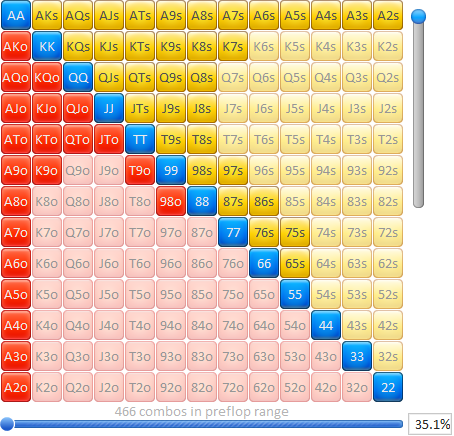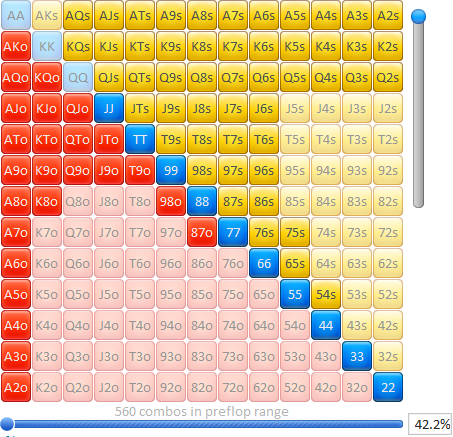- HOME
- BEST POKER TRAINING SITES
- POKER GUIDES
- ONLINE POKER ROOMS GUIDE
- POKER NOTES LIVE APP
- MORE
I love quizzes!
Quizzes test my knowledge and at the same time they access my competitive side… Gimme that perfect 100%!
So, I make sure to thoroughly read each question and each answer so that I select the right one every time.
I just released a new Quiz for members of my training site, thePokerForge.com. The quiz is called “HUD Statistics Quiz 1” and it tests your knowledge of various preflop and post-flop HUD statistics. It’s one of many quizzes in the HUD Mastery Course.
You don’t even have to be a HUD user to ace this quiz. Just use a little critical thinking and put yourself inside each situation and against the types of players described.
Here’s the deal: test your knowledge first by taking the quiz, THEN scroll further down to see the correct answers along with the strategies behind each one.
Good luck!
I hope you enjoyed the quiz.
You can retake the quiz as you go through the answers below to help you understand the correct answers and the strategies involved.


If the above statistical reads and exploits are intriguing to you, you must become a member of ThePokerForge.com. Click here to learn more and to join.
In my prior article called How to Study Poker: Learn Something, Do Something, I gave you a 4-step process for weekly studies.
Step 1 was to choose a strategy topic to focus on for the week. Yet, how do you know what topic to choose?
My recommendation is to take the next item from your list of weaknesses.
What? You don’t have one? Let me help you create a list of weaknesses that you can work from to improve your skills.

It doesn’t matter how good you are at poker, there’s always something that you can improve upon.
For many micro stakes and low-stakes players, maybe you’re weak at the fundamentals: 3-betting and c-betting and pre-flop bet sizing and going for value when you flop a strong hand.
For pros, they probably have the fundamentals down pat. However, maybe their weaknesses revolve around intricate stuff like check-raising the turn on dry boards or knowing when to bluff 25% pot versus 33% pot versus 150% pot.
There are two ways that I recommend for the “lone studier” (without a coach) to find their weaknesses.
Maybe this past week, you experienced this “unsure” spot four different times:
This is a sure sign that you need to study this situation to get more comfortable with these bluffing opportunities.
For online players, PokerTracker 4 is the #1 tool for spotting your weaknesses. It shows your tendencies in every situation and calculates your win rates when making different plays.
Maybe you think your game is spot on and you 3-bet bluff plenty, double-barrel c-bet all the time and you’re a winner when calling rivers.
But sometimes what we think about ourselves isn’t the truth. PokerTracker 4, however, shows us exactly the results of our time on-the-felt. There’s no hiding from this info.
Perhaps in your last 10,000 hands, PT4 shows you that:
When you find your weaknesses through paying attention to your play or via PT4, write them down.
You can do this however you want: in your poker journal, on your weekly calendar- or even on sticky notes attached to your monitor.
This is the list of weaknesses you’ll target on a weekly basis.
Moreover, to improve most efficiently, you need to prioritize your weaknesses.
Let’s imagine you’ve written these five weaknesses in your poker journal:
Before you begin working on your weaknesses one at a time, you must prioritize the list to maximize your study efficiency and to get the biggest bang for your study buck.
General rule: Work on the most common spots first, as well as quick fixes that yield great results.
Here’s how and why I would prioritize the list of weaknesses above:
#1: I Don’t Table Select
This is a very quick fix. If I target this weakness first, I’ll be at tables full of fish which makes poker easier and more fun. Plus, my bluff 3-bets will be more effective, I’ll be able to double-barrel more because they can’t stand the pressure and I won’t face as many river calling opportunities.
#2: I Fail to Target Players
Another quick fix. If I actively search for the weakest players to play hands against, poker will naturally be easier, more fun and more profitable. Plus, weak players won’t put me in tough post-flop spots as often.
#3: I Don’t 3-bet Bluff Enough
This one will take a bit longer to fix. However, if I can turn bad calls into good 3bet bluffs, I’ll be the one pressuring my opponents. I won’t face as many c-bets nor river bets, and I’ll be the one c-betting more often with stronger ranges.
#4: I Don’t Double-Barrel C-bet Enough
Now that I’m 3-betting more often and calling less, I’ll have stronger ranges with which to pressure my opponents on all three streets. I’ll include some range and board interaction studies to help me pull the trigger on more turn c-bets.
#5: I Lose Too Much When Calling Rivers
This could take a long time to fix without the above four fixes. With the above four in place, the players I get to the river against won’t be able to put so much post-flop pressure on me, so river decisions should be improved. And I will do some additional study into finding the fold when I know I’m beat.
With this prioritized list of weaknesses to tackle, you’ve got your work cut out for you.
Simply put all your focus on #1 until you feel comfortable with it and you see positive results.
I was going to end with “Good luck!” But, I recall that Louis Pasteur once said, “Luck favors the prepared mind.”
So, skip the luck and get to work to prepare your mind for better play!